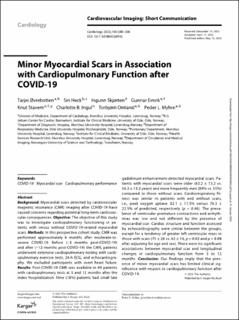| dc.contributor.author | Øvrebotten, Tarjei | |
| dc.contributor.author | Heck, Siri Lagethon | |
| dc.contributor.author | Skjørten, Ingunn | |
| dc.contributor.author | Einvik, Gunnar | |
| dc.contributor.author | Stavem, Knut | |
| dc.contributor.author | Ingul, Charlotte Ingeborg Björk | |
| dc.contributor.author | Omland, Torbjørn | |
| dc.contributor.author | Myhre, Peder Langeland | |
| dc.date.accessioned | 2024-02-01T14:52:03Z | |
| dc.date.available | 2024-02-01T14:52:03Z | |
| dc.date.created | 2023-09-15T12:17:45Z | |
| dc.date.issued | 2023 | |
| dc.identifier.citation | Cardiology. 2023, 148 (4), 300-306. | en_US |
| dc.identifier.issn | 0008-6312 | |
| dc.identifier.uri | https://hdl.handle.net/11250/3115123 | |
| dc.description.abstract | Background: Myocardial scars detected by cardiovascular magnetic resonance (CMR) imaging after COVID-19 have caused concerns regarding potential long-term cardiovascular consequences. Objective: The objective of this study was to investigate cardiopulmonary functioning in patients with versus without COVID-19-related myocardial scars. Methods: In this prospective cohort study, CMR was performed approximately 6 months after moderate-to-severe COVID-19. Before (∼3 months post-COVID-19) and after (∼12 months post-COVID-19) the CMR, patients underwent extensive cardiopulmonary testing with cardiopulmonary exercise tests, 24-h ECG, and echocardiography. We excluded participants with overt heart failure. Results: Post-COVID-19 CMR was available in 49 patients with cardiopulmonary tests at 3 and 12 months after the index hospitalization. Nine (18%) patients had small late gadolinium enhancement-detected myocardial scars. Patients with myocardial scars were older (63.2 ± 13.2 vs. 56.2 ± 13.2 years) and more frequently men (89% vs. 55%) compared to those without scars. Cardiorespiratory fitness was similar in patients with and without scars, i.e., peak oxygen uptake: 82.1 ± 11.5% versus 76.3 ± 22.5% of predicted, respectively (p = 0.46). The prevalence of ventricular premature contractions and arrhythmias was low and not different by the presence of myocardial scar. Cardiac structure and function assessed by echocardiography were similar between the groups, except for a tendency of greater left ventricular mass in those with scars (75 ± 20 vs. 62 ± 14, p = 0.02 and p = 0.08 after adjusting for age and sex). There were no significant associations between myocardial scar and longitudinal changes in cardiopulmonary function from 3 to 12 months. Conclusion: Our findings imply that the presence of minor myocardial scars has limited clinical significance with respect to cardiopulmonary function after COVID-19. | en_US |
| dc.language.iso | eng | en_US |
| dc.publisher | Karger | en_US |
| dc.rights | Navngivelse 4.0 Internasjonal | * |
| dc.rights.uri | http://creativecommons.org/licenses/by/4.0/deed.no | * |
| dc.title | Minor Myocardial Scars in Association with Cardiopulmonary Function after COVID-19 | en_US |
| dc.title.alternative | Minor Myocardial Scars in Association with Cardiopulmonary Function after COVID-19 | en_US |
| dc.type | Peer reviewed | en_US |
| dc.type | Journal article | en_US |
| dc.description.version | publishedVersion | en_US |
| dc.source.pagenumber | 300-306 | en_US |
| dc.source.volume | 148 | en_US |
| dc.source.journal | Cardiology | en_US |
| dc.source.issue | 4 | en_US |
| dc.identifier.doi | 10.1159/000530942 | |
| dc.identifier.cristin | 2175463 | |
| cristin.ispublished | true | |
| cristin.fulltext | original | |
| cristin.qualitycode | 1 | |

